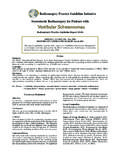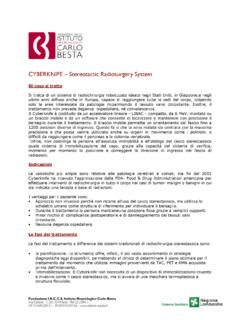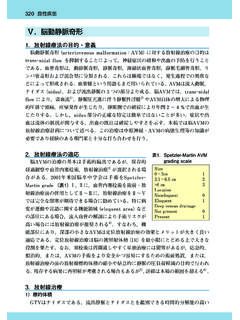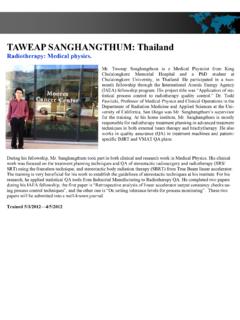Transcription of Radiosurgery Practice Guideline Initiative …
1 Radiosurgery Practice Guideline Initiative stereotactic Radiosurgery for Patients with Intracranial Arteriovenous Malformations (AVM) Radiosurgery Practice Guideline Report #2-03 Issued March 2009 ORIGINAL Guideline : September 2003 MOST RECENT LITERATURE SEARCH: March 2009 This Practice Guideline , together with a report on Intracranial Arteriovenous Malformations (AVM): Overview is an original Guideline approved by the IRSA (International Radiosurgery Association) Board of Directors and issued in March 2009. Preface Summary The IRSA (International Radiosurgery Association) Radiosurgery Practice Guideline Initiative aims to improve outcomes for intracranial arteriovenous malformations by assisting physicians and clinicians in applying research evidence to clinical decisions while promoting the responsible use of health care resources.
2 Copyright This Guideline is copyrighted by IRSA (2009) and may not be reproduced without the written permission of IRSA. IRSA reserves the right to revoke copyright authorization at any time without reason. Disclaimer This Guideline is not intended as a substitute for professional medical advice and does not address specific treatments or conditions for any patient. Those consulting this Guideline are to seek qualified consultation utilizing information specific to their medical situations. Further, IRSA does not warrant any instrument or equipment nor make any representations concerning its fitness for use in any particular instance nor any other warranties whatsoever. Key Words o arteriovenous malformations o AVM o vascular malformation o Gamma Knife o stereotactic Radiosurgery o linear accelerator o proton beam o irradiation o Bragg peak proton therapy Consensus Statement Objective To develop a consensus-based Radiosurgery Practice Guideline for treatment recommendations for brain or dural arteriovenous malformations (AVM) to be used by medical and public health professionals following the diagnosis of AVM.
3 Participants The working group included physicians and physicists from the staff of major medical centers that provide Radiosurgery . Evidence 1 2 The first authors (LDL/AN) conducted a literature search in conjunction with the preparation of this document and development of other clinical guidelines . The literature identified was reviewed and opinions were sought from experts in the diagnosis and management of brain AVMs, including members of the working group. Consensus Process The initial draft of the consensus statement was a synthesis of research information obtained in the evidence gathering process. Members of the working group provided formal written comments that were incorporated into the preliminary draft of the statement.
4 No significant disagreements existed. The final statement incorporates all relevant evidence obtained by the literature search in conjunction with final consensus recommendations supported by all working group members. Group Composition The Radiosurgery guidelines group is comprised of neurosurgeons, radiation oncologists and medical physicists. Community representatives did not participate in the development of this Guideline . Names of Group Members: L. Dade Lunsford, , Neurosurgeon, Chair; Douglas Kondziolka, , Neurosurgeon; Ajay Niranjan, , , Neurosurgeon; Christer Lindquist, , Neurosurgeon; Jay Loeffler, , Radiation Oncologist; Michael McDermott, , Neurosurgeon; Michael Sisti, , Neurosurgeon; John C.
5 Flickinger, , Radiation Oncologist; Ann Maitz, , Medical Physicist; Michael Horowitz, , Neurosurgeon and Interventional Radiologist; Tonya K. Ledbetter, , , Editor; Rebecca L. Emerick, , , , ex officio. Conclusions Specific recommendations are made regarding target population, treatment alternatives, interventions and practices and additional research needs. Appropriate use of Radiosurgery in those with AVM following medical management may be beneficial. This Guideline is intended to provide the scientific foundation and initial framework for patients who have been diagnosed with a brain or dural arteriovenous malformation. The assessment and recommendations provided herein represent the best professional judgment of the working group at this time, based on clinical research data and expertise currently available.
6 The conclusions and recommendations will be regularly reassessed as new information becomes available. stereotactic Radiosurgery Brain stereotactic Radiosurgery (SRS) involves the use of precisely directed, closed skull, single fraction (one session) of radiation to create a desired radiobiologic response within the brain with minimal effects to surrounding structures or tissues. In the case of an arteriovenous malformation, a relatively high dose of focused radiation is delivered precisely to the AVM under the direct supervision of a Radiosurgery team. The irradiated vessels gradually occlude over a period of time. In Centers of Excellence, the Radiosurgery team is composed of a neurosurgeon, radiation oncologist, physicist and registered nurse.
7 Intracranial Arteriovenous Malformation: Overview Pathophysiology and Incidence Intracranial arteriovenous malformations (AVM) constitute relatively rare and usually congenital vascular anomalies of the brain. AVMs are composed of complex connections between the arteries and veins that lack an intervening capillary bed. The arteries have a deficient muscularis layer. The draining veins often are dilated and tortuous due to the high velocity of blood flow through the fistulae. No genetic, demographic, or environmental risk factor has been associated with cerebral AVMs. Rarely inherited disorders, such as the Osler-Weber-Rendu syndrome (hereditary hemorrhagic telangiectasia), Sturge-Weber disease, neurofibromatosis, and von Hippel-Lindau syndrome are associated in a small minority of AVM patients.
8 It is estimated that 10,000 to 12,000 new patients are diagnosed in the United States on an annual basis. 3 Epidemiologic Features Sex Both sexes are affected equally. Age Although AVMs are considered congenital, the clinical presentation most commonly occurs in young adults (20 40 years). Brain hemorrhage or seizure as an incident event may occur in young children or adults over 40. A history of subtle learning disorders is elicited in 66% of adults with AVMs. Symptoms and Signs Arteriovenous malformation patients may present with brain hemorrhage, seizures, headache or progressive neurological deficit. Many AVMs are identified because of the sudden onset of bleeding within the brain, which can be fatal or merely lead to serious headache with or without new neurological deficits.
9 Deep-seated AVMs frequently present with hemorrhage. Hemorrhage may occur in the subarachnoid space, the intraventricular space or, most commonly, the brain parenchyma. The overall risk of intracranial hemorrhage in patients with known AVM is 2 4% per year. Specific angiographic features of the AVM increase the risk of hemorrhage. These include a small and only deep venous drainage, and relatively high arterial and venous pressures within the AVM nidus. Hemorrhage recurs in 15 20%, usually within the first year after the initial bleeding incident. Subcortical lobar AVMs may also present with seizures, progressive neurological deficits, or intractable vascular (migraine) headaches. Seizures occur as the presenting symptom in 25 50% of patients with AVM.
10 These may be focal or secondary generalized seizures. Headache occurs in 10 50% of patients with AVM. Refractory headaches may be a presenting symptom if seizures or hemorrhages do not occur. The headache may be typical for migraine or may be present with a less specific complaint of more generalized head pain. Rarely, a progressive neurological deficit may occur over a few months to several years. The neurological deficits may be explained by the mass effect of an enlarging AVM or venous hypertension in the draining veins. In the absence of mass effect, deficit could occur due to the siphoning of blood flow away from adjacent brain tissue (the steal phenomenon ). Imaging Studies Patients are identified by high resolution neurodiagnostic imaging including CT and MRI scans supplemented by complete cerebral angiography.







